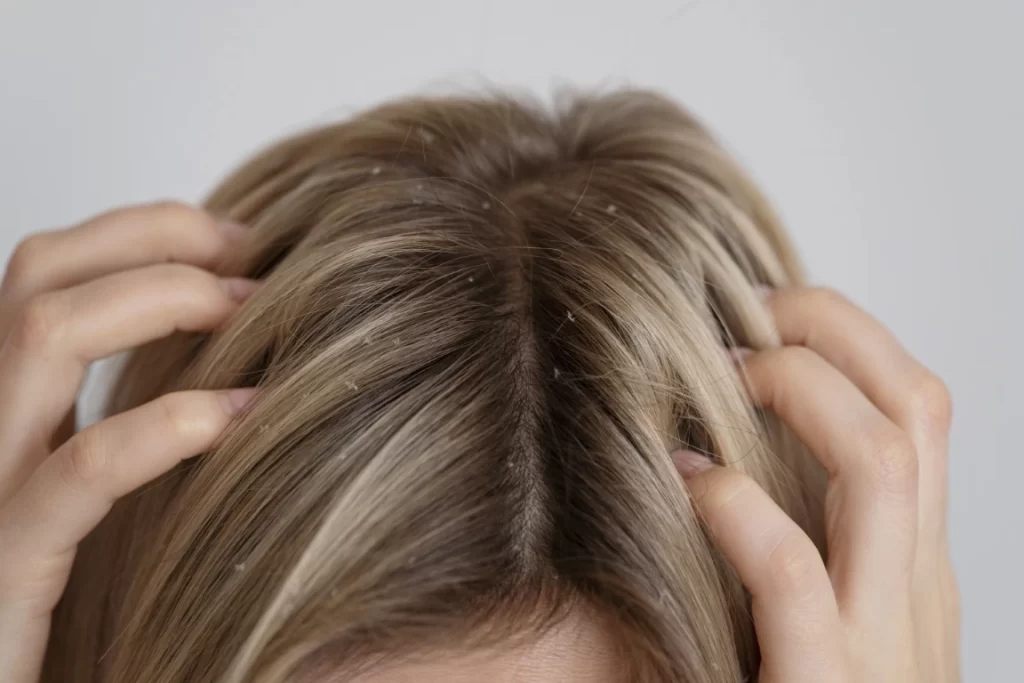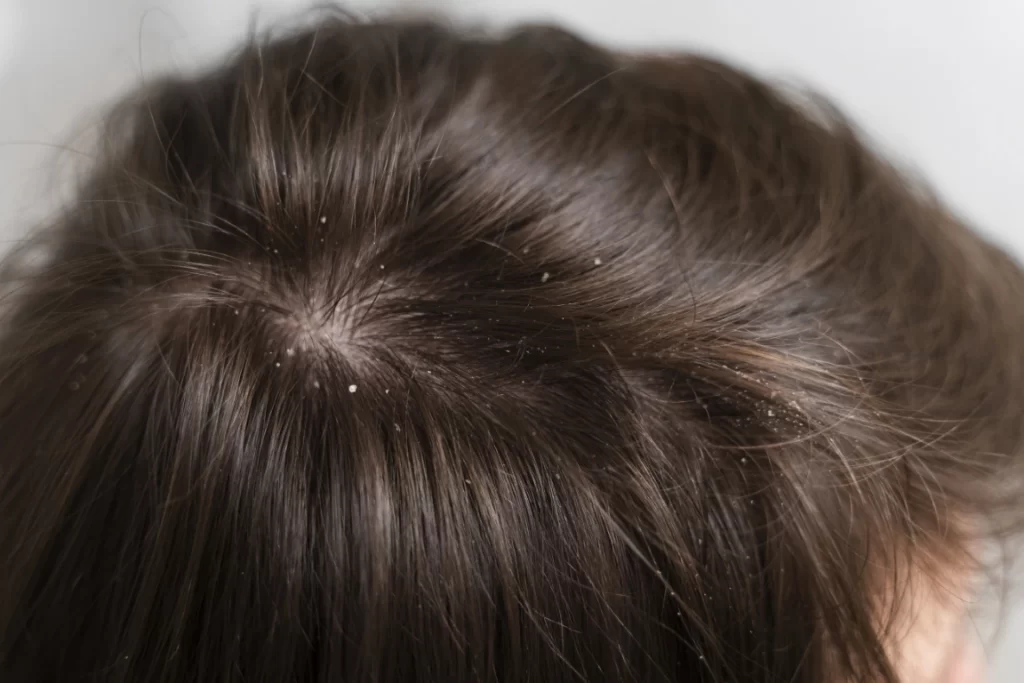Most people don’t have the right knowledge on how to prevent dandruff. 50% of the global adult population is affected by dandruff. However, due to a lack of awareness of the severity of the problem, many ignore it.

From Freepik
Dandruff is a skin condition that presents itself with flaking & scaling of the skin of the scalp. Its severe form is known as seborrheic dermatitis.
A dry scalp can also cause itching and scaling, so it’s important to differentiate them. If you experience flakiness and the rest of the skin on your body isn’t dry, it is dandruff. Scaly doesn’t mean it’s dandruff.
Dandruff is seen more commonly in men than women. According to studies, dandruff effects:
• 81% – 95% of African Americans
• 30% – 42% in Chinese populations
• 66% – 82% in Caucasians
• 60.1% of Indians.
It peaks around the age of 20 and declines after the age of 50. That’s why it’s necessary to treat them at the earliest.
Causes of Dandruff during winter
Here are the key causes of dandruff during winter:
Hair Products
Hair products with ingredients like sulfates, parabens, and fragrances might cause irritation in the scalp. This will lead to dryness and flaking, thus resulting in dandruff.
Heavy styling products containing silicon can lead to a build-up of flakes on the scalp. Frequent use of them will trap oil and dirt, increasing dandruff.

From Freepik
Prolonged use of Silicones like Dimethicone can cause flake buildup, clogging pores, and worsening flakiness. Alcohols commonly used in hair health can dry the scalp, contributing to flaking.
Excessive use of conditioners wash away the active ingredients in anti-dandruff shampoos. Plus, oily conditioners will worsen dandruff on oily scalps.
Yeast:
A yeast called Malassezia plays a key role in the development of dandruff. Overgrowth of this yeast causes inflammation in your joints and blood vessels.
The fungus thrives on scalp oils and produces oleic acid. It irritates the skin and triggers an inflammatory response.
It then accelerates skin cell turnover, leading to rapid shedding of dead skin cells as visible flakes. The combination results in the characteristic symptoms of dandruff, including itchiness and flaking.
Diet:
Your diet affects scalp health and can lead to dandruff. High sugar and processed carbs promote the growth of Malassezia, a yeast that causes flaking and itching. Spicy and oily foods also increase yeast and sebum production, worsening dandruff.

Image by freepik
Insufficient omega-3 fatty acids, zinc, and vitamin B deficiencies dry out and damage your skin. Dairy triggers inflammatory responses in gluten-intolerant people, which contributes to dandruff.
Stress:
Stress doesn’t directly cause dandruff, but it can significantly increase it. If you’re going through physical or psychological stress, your body will release excess cortisol. This increases sebum production on the scalp. Then, excess oil creates an ideal environment for yeast growth. It then results in more flakiness, giving a more itchy feeling.
Stress weakens the immune system, making it harder for the body to control fungal growth. The cortisol hormonal changes plus extra oil on the scalp increase your dandruff symptoms.
Weather:
Changes in humidity and temperature during different seasons are one of the main causes of dandruff.
In the winter, the cool air and the indoor room temperature might result in a lack of moisture on your scalp. This increases dandruff symptoms like flakiness & irritation symptoms.

Image by senivpetro on Freepik
In summer, the heat combined with the high humidity sweats your scalp. This sweating builds up oils & piles up dead skin cells.
In the monsoon season, the humidity of the air increases. The humidity leads to excessive moisture on your scalp, giving space to more fungal growth, leading to dandruff.
3 Signs of Dandruff
Here are 3 signs that mean you have dandruff:
1. White Flakes
White flakes are the most obvious sign of dandruff. They come from your scalp and often land on your clothes.
2. Itchiness
An itchy scalp often accompanies dandruff. The irritation makes you want to scratch, which worsens the problem.
3. Dry or Oily Scalp
Your scalp might feel extra dry or greasy when you have dandruff. Both conditions create an environment where dandruff thrives.
8 tips to get rid of dandruff during winter
Here are 8 tips I curated from my dermatologist to get rid of dandruff during cold months:
1. Use a Moisturizing Anti-Dandruff Shampoo
Look for a shampoo that fights dandruff and keeps your scalp hydrated.
The ingredients might look like this
• Zinc Pyrithione to reduce fungal growth
• Salicylic acid to remove dead skin cells
• Ketoconazole to fight fungal infections
• Tea tree oil to keep the scalp cool
• Ciclopirox for anti-inflammation
• Selenium Sulfide for reducing irritation & redness
Let the shampoo sit for 3 minutes before washing. Make it enter the depths of your hair. Use it consistently to control flakes.
2. Wash Your Hair Regularly
Wash your hair at least three times a week. This removes dirt, oil, and dead skin, preventing dandruff buildup. If you don’t wash your hair regularly, the oils and dead skin will pile up, leading to inflammation. Washing your hair regularly will ensure your scalp stays clean of unwanted scales and flakes.
3. Avoid Hot Showers
Hot water strips your scalp of moisture. Use lukewarm water instead to keep your scalp hydrated. Luke warm water maintains the correct balance of oils you need in your scalp. Cleaning the oils is necessary, but removing the natural oils during the process will produce more sebum. Which in turn will lead to more dandruff.
4. Stay Hydrated
Drink enough water daily. Hydration starts from the inside, and it helps keep your scalp healthy. The experts recommend drinking an ounce of water in the morning. Then, drink 1 liter of water for the rest of the day. A dehydrated body leads to more sebum production, causing dandruff.
5. Use a Humidifier Indoors
Heating systems dry out the air in your home. A humidifier adds moisture to the air, helping your scalp stay hydrated. The moisture makes sure your scalp gets the necessary oils. Lack of moisture in the scalp leads to excessive oil production; when the scalp does not absorb this excessive oil, it creates a dandruff-causing environment.
6. Have More Cold Showers
Take more cold showers. It helps maintain your scalp’s moisture level and prevents dirt from accumulating. It also helps preserve your hair’s natural oils.
Keep your showers short and not too hot. This prevents your scalp from drying out further. If your scalp is dry, your body will produce more oils to replace it. This is unpleasant because it might increase the chances of dandruff. Maintain your scalp condition by not exposing yourself to more hot showers.
7. Eat Zinc-Rich Foods
Diet plays an important role in reducing dandruff. If you eat excess oily and spicy foods, chances are you will increase the chances of having dandruff.
Zinc helps keep your scalp healthy. Include foods like nuts, seeds, and whole grains in your meals. Zinc-rich foods help maintain your balance for your scalp. It helps to relieve your scalp from itching and flaking.
8. Brush Hair Regularly
Brushing your hair helps distribute natural oils across your scalp. This keeps it moisturized and less prone to flaking. It helps in blood circulation, too.
Brushing regularly removes the unwanted flakes and dry skins from your scalps. Ensure unwanted oils and scales don’t get piled up in your scalp.
Use a scalp massager while shampooing. You can do it before shampooing too.
3 home remedies to control dandruff
1. Yoghurt & Honey Mask:
Mix plain yogurt and honey. Apply it to your scalp and leave it on for 20 minutes. Rinse with lukewarm water. This soothes your scalp and reduces flakes.
2. Papaya & Honey Mask:
Mash a ripe papaya and mix it with honey. Apply the paste to your scalp and let it sit for 30 minutes. Rinse thoroughly. This removes dead skin and hydrates your scalp.
3. Fenugreek & Yoghurt Mask:
Soak fenugreek seeds overnight, then grind them into a paste. Mix the paste with yogurt and apply it to your scalp. Leave it for 30 minutes before rinsing. This fights fungal growth and reduces dandruff.
Conclusion:
Dandruff cannot be cured, it’s a chronic or long-standing condition. Maintenance therapy is required to keep the scalp clear. Apply the home remedies if the dandruff is not too much. If the condition is too severe, visit a dermatologist and a skin specialist.
FAQ’s
1. What are the best remedies for dandruff in winter?
Ans: Here are quick remedies for winter dandruff:
- Yoghurt & Honey Mask:
- Apply a mix of 2 tbsp of yogurt and 1 tbsp honey for 20-30 minutes.
- Coconut Oil: Massage 2 tbsp of coconut oil into your scalp.
- Papaya & Honey Mask: Use ½ cup mashed papaya with 2 tbsp honey for hydration.
- Fenugreek & Yoghurt Mask: Soak ¼ cup fenugreek seeds, grind, and mix with 1 cup yogurt; apply for 30 minutes.
- Amla Juice: Apply fresh amla juice to the scalp.
- Aloe Vera: Use aloe vera gel for moisture.
- Baking Soda: Exfoliate your scalp with baking soda.
- Dietary Adjustments: Eat zinc-rich foods and stay hydrated.
2. How does indoor heating contribute to dandruff
Ans: Indoor heating dries out the scalp, leading to irritation and increased dandruff, especially for those sensitive to Malassezia. Use moisturizing shampoos and keep the scalp hydrated to help.
3. Can using a hair dryer worsen dandruff symptoms?
Ans: Yes, using a hair dryer can worsen dandruff by drying out the scalp and increasing irritation.
To minimize effects:
• Use lower heat settings.
• Avoid prolonged use in one area.
• Consider heat protectants.
4. How does dry air in winter affect scalp health?
Ans: Dry air in winter can harm scalp health in several ways:
- Low Humidity: Winter air lacks moisture, leading to a dry and flaky scalp.
- Indoor Heating: Central heating reduces humidity indoors, making the scalp even drier and more irritated.
- Oil Imbalance: Cold temperatures can disrupt natural oil production, causing either too much oil or dryness, which worsens dandruff.
- Increased Itching and Flaking: A dry scalp can lead to more itching and flaking, often mistaken for dandruff.
- Wearing Hat: Hats can trap heat and moisture, promoting fungal growth and worsening dandruff.
5. How can I tell if my scalp is too dry or oily?
Ans: To tell if your scalp is too dry or too oily, look for these signs:
Signs of a Dry Scalp:
- Itching: Feels itchy and irritated.
- Flaky Skin: Small, dry flakes fall from your hair.
- Tightness: A tight feeling on the scalp.
- Lack of Oil: Produces little to no oil.
Signs of an Oily Scalp:
- Greasy Hair: Hair feels greasy within a day of washing.
- Large Flakes: Yellowish, larger flakes that stick to the scalp.
- Product Buildup: Hair feels weighed down by excess oil.
- Sebum Overproduction: Excessive oiliness on the scalp.
Quick Test:
1. Don’t wash your hair for two days
2. Press blotting paper against your scalp for 20 seconds.
3. Check the wet patch:
Small patch: Dry scalp.
Large patch: Oily scalp.









Leave a Comment